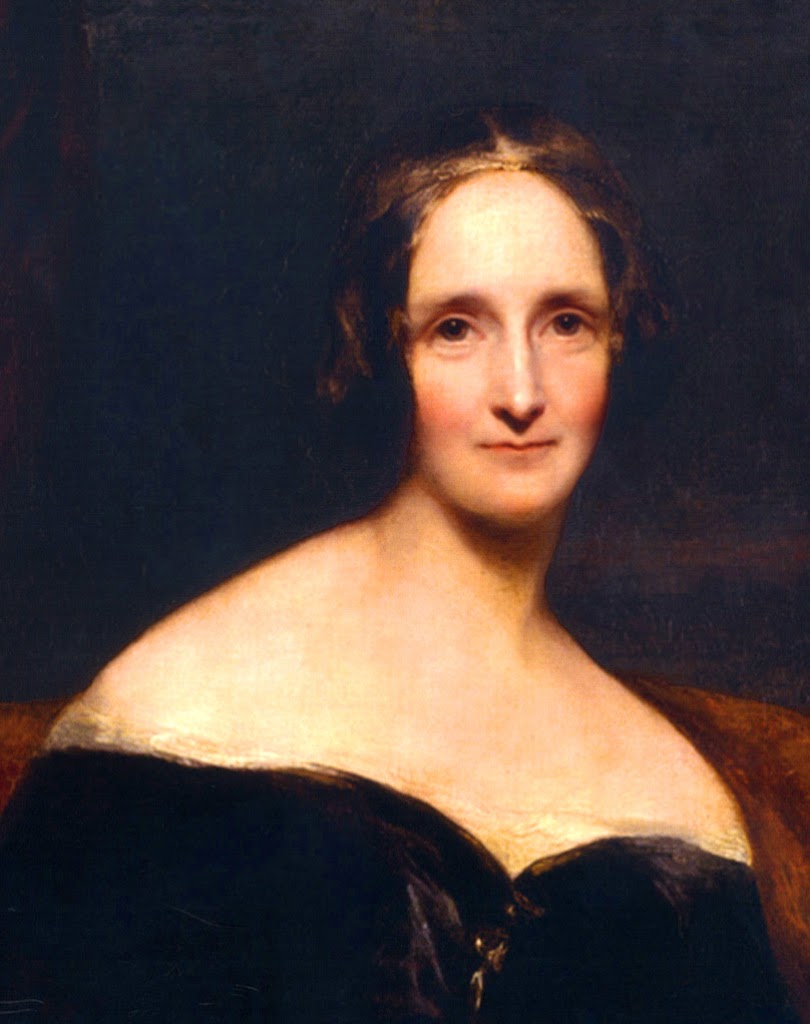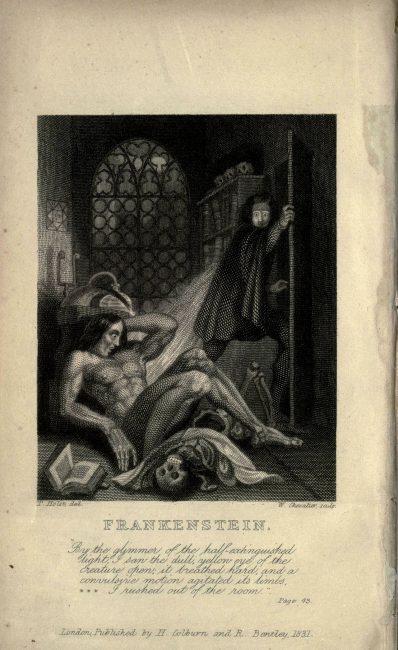
Mary Wollstonecraft Shelley (1797-1851)
Only a few 19th century literary works have become an icon in today’s popular culture. Among them are the detective story and its most prominent protagonist Arthur Conan Doyle‘s Sherlock Holmes as well as some of the gothic horror novels, primarily Bram Stoker‘s Dracula and Mary Shelley’s Frankenstein.[4,5]
“What was I? Of my creation and creator I was absolutely ignorant, but I knew that I possessed no money, no friends, no kind of property. I was, besides, endued with a figure hideously deformed and loathsome; I was not even of the same nature as man. I was more agile than they and could subsist upon coarser diet; I bore the extremes of heat and cold with less injury to my frame; my stature far exceeded theirs. When I looked around I saw and heard of none like me. Was I, then, a monster, a blot upon the earth, from which all men fled and whom all men disowned?”
— Mary Shelley, Frankenstein; or, The Modern Prometheus (1818)
Mary Shelley’s Youth
Born as Mary Godwin on August 30, 1797, Mary Wollstonecraft Shelley was the second child of the feminist philosopher, educator, and writer Mary Wollstonecraft, and the first child of the philosopher, novelist, and journalist William Godwin. Unfortunately, her mother died of puerperal fever soon after Mary was born. Godwin was left alone to bring up Mary along with her older half-sister. On December 21, 1801, William Godwin married Mary Jane Clairmont, who lived in the neighborhood and was pregnant by him. While William Godwin was very fond of his second wife until the end of his life, Mary Godwin rejected her stepmother in the following years with increasing intensity. At age 15 as an almost grownup teenager, Mary’s father described her as “singularly bold, somewhat imperious, and active of mind. Her desire of knowledge is great, and her perseverance in everything she undertakes almost invincible.“
Meeting Percy Bysshe Shelley
By 1814 Mary Godwin first met the radical poet-philosopher Percy Bysshe Shelley,[3] who had become estranged from his wife and was regularly visiting William Godwin, whom he had agreed to bail out of debt. Percy Shelley’s radicalism, particularly his economic views, had alienated him from his wealthy aristocratic family. Therefore, he had difficulty gaining access to money until he inherited his estate. Mary and Percy began meeting each other secretly at Mary Wollstonecraft’s grave in St Pancras Churchyard, and they fell in love. But to Mary’s dismay, her father disapproved. On 28 July 1814, the couple secretly left for France, taking Mary’s stepsister, Claire Clairmont, with them, but leaving Percy’s pregnant wife behind. The three travelled to Paris, and then, by donkey, mule, carriage, and foot, through a France recently ravaged by war, to Switzerland, but lack of money forced the trio to turn back to England.
The Trip to Switzerland and the Birth of the Monster
Having settled somehow their difficult situation, a second trip to Switzerland followed in 1816 that should become one of the most told episodes in the history of literature about the birth of a literary masterpiece. Mary, Percy, and Claire Clermont planned to spend the summer together with the poet Lord Byron,[7] whose recent affair with Claire had left her pregnant. Byron together with his young physician, John Polidori, rented the Villa Diodati, close to Lake Geneva at the village of Cologny. They spent their time writing, boating on the lake, and talking late into the night. “It proved a wet, ungenial summer and incessant rain often confined us for days to the house” Mary Shelley wrote in 1831. Their conversations turned to the experiments of the natural philosopher and poet Erasmus Darwin, who was said to have animated dead matter, and to galvanism and the feasibility of returning a corpse or assembled body parts to life. Sitting around a log fire at Byron’s villa, the company also amused themselves by reading gothic novels and ghost stories. Thus, Byron suggested that they each should write their own supernatural tale. Shortly afterwards, in a waking dream, Mary Shelley conceived the idea for Frankenstein:
“I saw the pale student of unhallowed arts kneeling beside the thing he had put together. I saw the hideous phantasm of a man stretched out, and then, on the working of some powerful engine, show signs of life, and stir with an uneasy, half vital motion. Frightful must it be; for SUPREMELY frightful would be the effect of any human endeavour to mock the stupendous mechanism of the Creator of the world.” from Mary Shelley’s introduction to the 1831 edition of Frankenstein.
She began writing and with Percy’s encouragement the tale finally became a full-fledged novel. But it was a fruitful stay also for the other members of the party. Byron managed to write just a fragment based on the vampire legends he heard while travelling the Balkans, and from this John Polidori created ‘The Vampyre‘ (1819), the progenitor of the romantic vampire literary genre. Thus, two legendary horror tales originated from this one circumstance.

Inside cover art from the 1831 edition of Frankenstein
Marriage and Frankenstein’s Publication
Upon their return to England, Mary Godwin and Percy Shelley settled in Bath and were married in London on 30 December 1816. In November 1817 the travel story “History of a Six Weeks’ Tour” was published, which Mary Godwin had written on the basis of the revised letters and diary entries from her two journeys to Switzerland. On 1 January 1818 followed the publication of “Frankenstein“. The book was published without reference to an author, but with a foreword by Percy Shelley and was dedicated to William Godwin. Critics and readers concluded that Percy Shelley was the author. Although Sir Walter Scott praised the novel in his review, it was initially not a sales success.
Shelley’s Death and later Life
The Shelleys left Britain in 1818 for Italy, where their second and third children died before Mary Shelley gave birth to her last and only surviving child, Percy Florence Shelley. In 1822, her husband drowned when his sailing boat sank during a storm near Viareggio. A year later, Mary Shelley returned to England and from then on devoted herself to the upbringing of her son and a career as a professional author. The last decade of her life was dogged by illness, probably caused by the brain tumor that was to kill her in 1851 at the age of 53.
Mary Shelley’s novel and the famous character of Frankenstein’s monster have influenced popular culture for at least 100 years. The work has inspired numerous films, television programs, video games and derivative works. Today, the character of the monster remains one of the most recognized icons in horror fiction. But anyway, if you haven’t read Mary Shelleys novel by now, you should. It’s definitively worth while!
“Mothering Monsters: Mary Shelley’s Frankenstein” by Anne K. Mellor, [8]
References and further Reading:
- [1] Mary Shelley’s Frankenstein and its composition at Wikipedia
- [2] Mary Shelley: Frankenstein or The new Prometheus, original text at gutenberg.org
- [3] Gothic – the Life and Works of Percy Bysshe Shelley at SciHi Blog
- [4] Elementary, my Dear Watson! – Sir Arthur Conan Doyle and his famous Sherlock Holmes, SciHi Blog
- [5] Count Vampyre from Styria – or what Bram Stoker did not write, SciHi Blog
- [6] Mary Shelley at Wikidata
- [7] Wicked Lord Byron’s Wonderful Poetry, SciHi Blog
- [8] “Mothering Monsters: Mary Shelley’s Frankenstein” by Anne K. Mellor, Department of English, Arizona State University @ youtube
- [9] Sampson, Fiona (2016). “Frankenstein at 200: Why Hasn’t Mary Shelley Been Given the Respect She Deserves?”. The Guardian.
- [10] Howard, Jennifer (7 November 2008). “The Birth of ‘Frankenstein’“. The Chronicle of Higher Education.
- [11] Morrison, Lucy; Stone, Staci (2003). A Mary Shelley Encyclopedia. Greenwood Publishing Group.
- [12] Bennett, Betty T.; Curran, Stuart (2000). Mary Shelley in Her Times. Johns Hopkins University Press.
- [13] Timeline for Mary Shelley, via Wikidata





